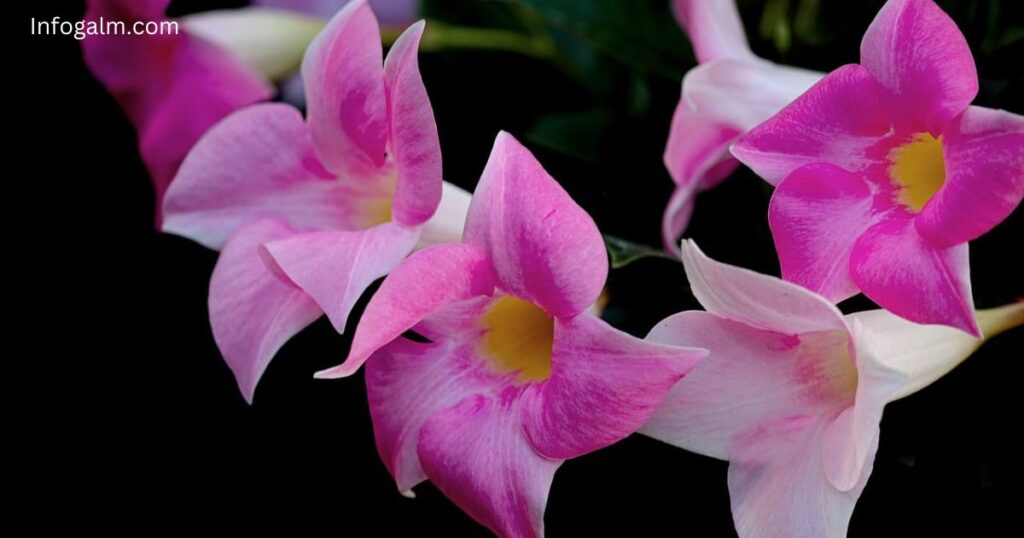Key Takeaways
- Dipladenia is a tropical plant known for its vibrant flowers, which are ideal for adding color to small or large gardens.
- It’s easy to care for, heat-tolerant, and perfect for sunny spots.
- Dipladenia grows more compact like Mandevilla, making it ideal for pots and smaller spaces.
- Regular watering and well-drained soil are essential for healthy growth.
Dipladenia: A Beautiful Plant for Your Garden
Are you looking for a low-maintenance plant to brighten up your garden? Dipladenia might be just what you need. It offers beautiful blooms and easy care, perfect for any outdoor space.
What Is Dipladenia?
Dipladenia is a tropical plant that thrives in warm weather and sunlight. Its trumpet-shaped flowers, in shades of pink, red, or white, contrast beautifully with its dark green leaves. Although closely related to Mandevilla, Dipladenia grows more compactly, making it a great choice for pots, hanging baskets, or garden beds.
Dipladenia vs. Mandevilla: What’s the Difference?
While often confused with Mandevilla, Dipladenia differs in its growth habit. Mandevilla is a vigorous climber that thrives on trellises and fences, whereas Dipladenia remains lower to the ground, offering a more manageable, bushier option for smaller spaces.
Why Choose Dipladenia?
Dipladenia is a fantastic addition to any garden for several reasons:
- Gorgeous Flowers: Its vibrant blooms stand out, adding a striking pop of color to any garden or patio.
- Easy to Care For With minimal requirements, Dipladenia is perfect for gardeners seeking a low-maintenance yet beautiful plant.
- Heat Tolerance: Dipladenia thrives in hot conditions, which is ideal for warm climates or summer gardens.
- Perfect for Small Spaces: This plant grows compactly, which is perfect for container gardening or smaller areas.
How to Plant and Care for Dipladenia
To help your Dipladenia flourish, follow these simple steps:
- Pick a Sunny Spot: They loves sunlight, so place it in a location with plenty of direct sunlight for best growth.
- Use Well-Drained Soil: Ensure the soil drains well to prevent waterlogging, which can lead to root rot. Adding sand or perlite can improve drainage in pots.
- Water When Needed: Water your Dipladenia regularly, but avoid overwatering. Let the top inch of soil dry out before the next watering.
- Fertilize for More Blooms: Use a balanced fertilizer every few weeks during the growing season to encourage more flowers.
FAQS
1. Does Dipladenia need pruning?
Yes, occasional pruning keeps it neat and encourages more blooms. Trim dead or overgrown parts as needed.
2. Can Dipladenia survive the winter?
It is not frost-tolerant. If you live in a colder climate, bring it indoors before temperatures drop and place it in a sunny spot until spring.
3. Is Dipladenia safe for pets?
No, Dipladenia is toxic to pets if ingested. Keep it out of reach from curious cats or dogs.
Fun Facts About Dipladenia:
- It attracts pollinators like bees and butterflies, making it a lovely addition to pollinator-friendly gardens.
- Dipladenia comes from Greek, meaning “double gland,” referring to the plant’s flower structure.
- Dipladenia is drought-tolerant and ideal for hotter climates or areas with occasional dry spells.
Final Thoughts
Dipladenia is a versatile and beautiful plant that brings color and life to any garden. Whether you’re a beginner or an experienced gardener, this low-maintenance tropical plant is sure to impress. Perfect for pots or garden beds, its stunning flowers will brighten your space with minimal effort.







